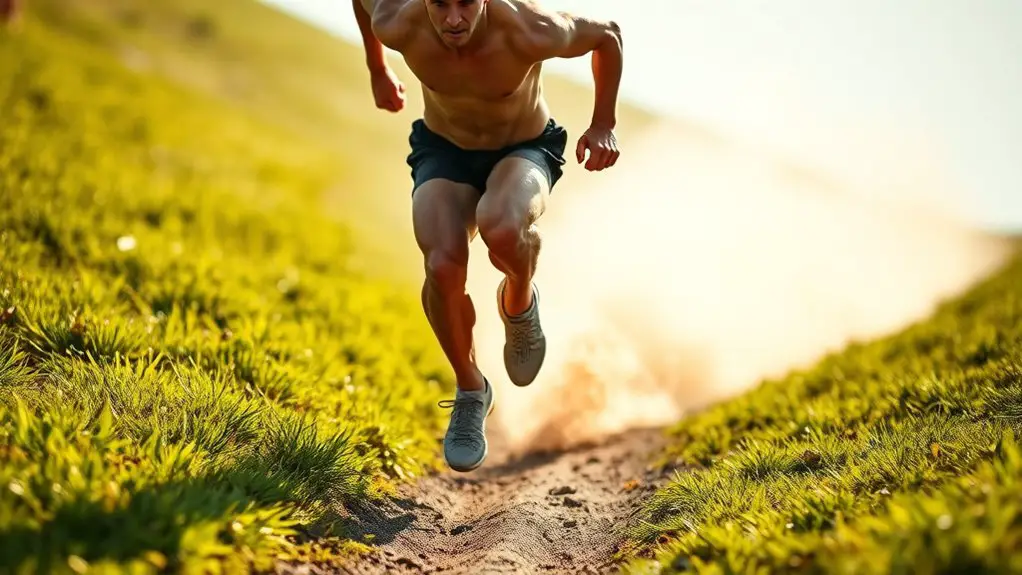Cadence plays an essential role in your cycling performance by affecting your efficiency, endurance, and power output. By maintaining a favorable cadence, you can enhance your ride while minimizing fatigue. Different cadences recruit various muscle fibers, impacting your strength and endurance on the bike. Adjusting your cadence based on terrain is also important for maximizing performance. Want to fine-tune your approach and discover more about how cadence can elevate your cycling experience?
Understanding Cadence: Definition and Importance
Cadence, often referred to as the rhythm of your pedal strokes, plays an essential role in cycling performance. When you find your ideal cadence, you access numerous cadence benefits that can enhance your ride. Understanding cadence metrics, like revolutions per minute, helps you gauge your efficiency and power output. A higher cadence can lead to smoother rides, reducing fatigue and allowing you to ride longer distances with ease.
The Science Behind Cadence and Energy Expenditure
Finding your ideal cadence not only enhances your cycling experience but also directly influences how much energy you expend. When you pedal at a rhythm that feels natural, you tap into peak energy metabolism, allowing your body to work efficiently. This cadence efficiency means you're converting fuel into motion with less wasted effort, giving you the freedom to ride longer and harder without burning out.
Research shows that maintaining a consistent cadence can help regulate your heart rate and reduce muscle fatigue. By avoiding extremes, you can keep your energy levels steady, letting you enjoy the ride without the dreaded energy crash.
Optimal Cadence: Finding Your Personal Sweet Spot
How can you discover your ideal cadence for cycling? Finding your personal sweet spot can elevate your riding experience. It's about tuning into your body and experimenting with different rhythms. Here's how to get started:
- Conduct a Personal Analysis: Track your current cadence during various rides. Use a cycling computer or app to gather data.
- Incorporate Cadence Drills: During training, dedicate sessions to practice higher and lower cadences. Alternate between 60-70 RPM and 80-90 RPM to see how each feels.
- Listen to Your Body: Pay attention to how your legs feel at different cadences. Look for a rhythm that feels natural and allows you to maintain endurance without fatigue.
Ultimately, it's about freedom on the bike. Embrace the journey of finding what works for you, and you'll reveal your cycling potential!
Cadence and Muscle Recruitment: How It Affects Performance
When you pedal at different cadences, you're not just changing speed; you're altering which muscle fibers get activated. This can considerably impact your endurance and power outputs, depending on your ideal cadence range. Understanding this relationship can help you fine-tune your performance on the bike.
Muscle Fiber Activation
While many factors influence cycling performance, muscle fiber activation plays an essential role in how effectively you can sustain different cadences. Understanding the relationship between cadence and muscle activation helps you maximize your potential. Different fiber types respond uniquely to varying cadences, which can impact your ride considerably. Here are three key points to reflect on:
- Fast-twitch fibers are activated more at higher cadences, providing explosive power for short bursts.
- Slow-twitch fibers thrive at lower cadences, supporting endurance and sustaining longer rides.
- Balanced recruitment of both fiber types can enhance overall performance, allowing you to adapt to diverse cycling conditions.
Endurance vs. Power
Understanding the balance between endurance and power is essential for optimizing your cycling performance, as different cadences engage your muscle fibers in unique ways. When you're focused on endurance training, a higher cadence can help you recruit slow-twitch muscle fibers, enhancing your stamina for those long rides. On the flip side, lower cadences emphasize fast-twitch fibers, boosting your power output for short bursts or climbs. Finding the right mix allows you to enjoy the freedom of cycling, whether you're tackling steep hills or cruising on flat terrain. Experiment with various cadences during your rides to discover what feels best for you, striking that perfect balance between endurance and power, and ultimately elevating your cycling experience.
Optimal Cadence Range
Finding your ideal cadence range is essential for maximizing cycling performance, as it directly influences muscle recruitment and efficiency. Striking the right balance can help you pedal with freedom, boosting your overall ride. Here's how to identify your best RPM:
- Experiment with Cadence Variability: Try different cadences during your rides to see what feels most natural and efficient for you.
- Listen to Your Body: Pay attention to how your muscles react at various RPMs. Are they feeling fatigued, or do you feel strong?
- Monitor Performance: Track your speed and endurance at different cadences. This data can guide you to find that sweet spot that enhances your cycling experience.
Embrace the journey to discover what works best for you!
The Impact of Terrain on Cadence Choices
When you're cycling, the terrain can greatly influence your cadence choices. On flat roads, you might find a higher cadence works best for maintaining speed, while climbing demands a more controlled approach. Understanding these shifts can help you optimize your performance across different surfaces.
Flat Terrain Strategies
Flat terrain presents a unique opportunity for cyclists to optimize their cadence strategies. When you're cruising on a flat stretch, you can fine-tune your flat terrain pacing and gear selection to enhance your ride. Here are three key strategies to contemplate:
- Maintain a Steady Cadence: Aim for a consistent rhythm, typically between 80-100 RPM, to maximize efficiency.
- Adjust Gear Selection: Use a higher gear to maintain speed while keeping your cadence steady; this reduces fatigue over long distances.
- Utilize Drafting: If you're riding with others, draft behind them to conserve energy. This allows you to focus on your cadence without expending unnecessary effort.
Climbing Cadence Adjustments
On flat terrain, maintaining a steady cadence can greatly boost your efficiency. But when it comes to climbing, you'll need to adapt your cadence to tackle varied gradients. Use effective climbing techniques and smart gear selection to find a balance between power output and endurance. Adjust your cadence based on the hill's steepness; a lower cadence might help manage fatigue on steep ascents. Incorporate hill intervals into your training for better terrain adaptation. Remember, breathing control is essential during climbs—keep it steady to maintain energy. By mastering these adjustments, you'll optimize your performance and enjoy that exhilarating sense of freedom on every ascent. Embrace the challenge, and let your legs find their rhythm.
Training Strategies to Improve Cadence
To boost your cycling cadence effectively, incorporating specific training strategies can make all the difference. Here are three essential methods to enhance your cadence and cycling efficiency:
Boost your cycling cadence with targeted training strategies for improved efficiency and performance.
- Cadence Drills: Focus on high-cadence drills during your rides. Aim for a rhythm that feels natural and fluid, enhancing your pedal technique.
- Interval Training: Integrate short bursts of high-cadence intervals into your workouts. This not only builds strength but also improves your overall fitness assessments.
- Gear Selection: Experiment with different gears to find the best combination for maintaining a higher cadence. Proper gear selection allows for smoother shifts and less strain on your legs.
Don't forget to include recovery rides in your routine. They'll help you maintain rhythm focus while preventing burnout. Embrace these strategies, and you'll find your cadence soaring!
Common Mistakes Cyclists Make With Cadence
Many cyclists unknowingly fall into common cadence traps that can hinder their performance. One of the biggest cadence misconceptions is thinking that a higher cadence is always better. While spinning can feel liberating, too high a cadence might lead to a loss of power and control. Instead of just chasing numbers, it's essential to find a rhythm that suits your body and riding style.
Another mistake is not adjusting expectations based on terrain. Riding uphill may require a lower cadence to maintain strength, while flat stretches might call for a quicker spin. Ignoring these nuances can lead to frustration and fatigue.
Lastly, many cyclists overlook the importance of practicing cadence in various conditions. Embracing a flexible approach allows you to adapt and thrive. Remember, cadence isn't just about speed; it's about finding your personal groove and enjoying the ride.
Monitoring Cadence: Tools and Techniques for Success
Monitoring your cadence effectively can make a significant difference in your cycling performance. To truly harness the power of cadence monitoring, you'll want to utilize the right tools and techniques for accurate cadence analysis. Here are three essential methods to help you ride free and fast:
- Cycling Computers: Invest in a reliable cycling computer that tracks your cadence in real-time. This tech keeps you informed, allowing you to adjust your pedaling instantly.
- Smartphone Apps: Use mobile apps designed for cyclists. Many offer cadence tracking features and detailed analysis, making it easy to review your performance post-ride.
- Cadence Sensors: Attach cadence sensors to your bike's crank or pedal. These devices provide precise data, giving you valuable insights into your pedaling efficiency.
With these tools in hand, you'll gain the freedom to optimize your cycling and reach new heights in your performance.
Frequently Asked Questions
How Does Cadence Affect Heart Rate During Cycling?
When you ride, your cadence measurement can greatly impact your heart rate. A higher cadence often leads to increased heart rate variability, which can enhance your cardiovascular efficiency. By finding your ideal cadence, you can balance effort and endurance, allowing you to ride longer and feel freer. It's all about understanding how your body responds to different speeds and adjusting your cycling rhythm for a more enjoyable and effective ride.
Can Cadence Influence Cycling Injury Risk?
Can cadence influence cycling injury risk? Absolutely! By making cadence adjustments, you can reduce strain on your muscles and joints, helping with injury prevention. When you find a rhythm that feels comfortable, it not only enhances your ride but also keeps your body in a safer position. So, don't hesitate to experiment with different cadences; you'll find a sweet spot that allows you to enjoy the freedom of cycling while minimizing injury risks.
What Is the Ideal Cadence for Different Cycling Disciplines?
Did you know that cyclists often perform best at a cadence of 90-100 RPM? For road cycling, a higher cadence can enhance efficiency, while mountain biking often benefits from a lower, more controlled pace around 70-80 RPM. In track cycling, maintaining a steady 100+ RPM is key for speed. For time trialing, finding your sweet spot between 85-95 RPM can help balance power and endurance, giving you the freedom to push your limits.
How Does Cycling Cadence Relate to Weight Loss?
When you cycle at varying cadences, you can influence your caloric burn and metabolic rate. Higher cadences often lead to increased heart rates, which can enhance your overall energy expenditure. If you're looking to lose weight, finding a rhythm that feels comfortable but challenges you can help you shed those extra pounds while enjoying the ride. Embrace the freedom of cycling, and let your body dictate the best cadence for your goals.
Are There Age-Related Changes in Optimal Cadence?
As you age, you might notice some changes in your ideal cadence due to various age factors. Your body may not respond the same way as it did when you were younger, leading to cadence variability. It's important to listen to your body and adjust your cycling style accordingly. Finding that sweet spot can enhance your riding experience, giving you the freedom to enjoy cycling at any age without pushing beyond your limits.




